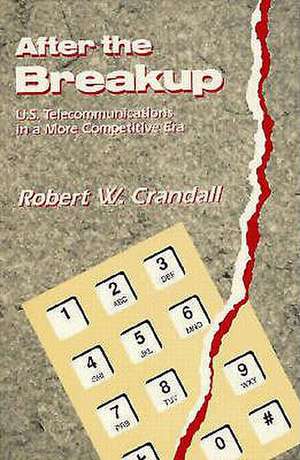After the Breakup: U.S. Telecommunications in a More Competitive Era
Autor Robert W. Crandallen Limba Engleză Paperback – 1991
The U.S. telecommunications industry has undergone dramatic changes in recent years that have touched almost every American home and business. The average American can dial almost anywhere in the world directly, store and forward a message, or transmit a fax in less than a minute; often for less than the real cost of a 500-mile telephone call tweny-five years ago. The combination of telecommunications breakthroughs, competition among new and old carriers, and the AT&T breakup has transformed the telephone industry and provided customers with a new array of equipment and services.
Robert W. Crandall examines the effects of the AT&T breakup and weighs the costs and benefits to the residential and business consumer. On balance, he finds that the efficiency gains from opening up the telephone industry have more than offset the possible efficiency losses, which may be caused by the sacrifice of economies of scale and scope or the absence of fully compatible equipment and services. The replacement of regulation with competition has led to greater productivity in the telephone industry, a more efficient rate structure, and lower equipment prices.
Crandall traces the telecommunications evolution from its early beginnings as pairs of copper wires up through the historic 1982 decision to divest. He investigates the impact of technological changes, competition, and the advent of divestiture on the quality of service, local and interexchange service rates, productive efficiency, and income distribution. He also focuses on problems that linger after the breakup in the increasingly competitive but highly regulated sector.
Robert W. Crandall examines the effects of the AT&T breakup and weighs the costs and benefits to the residential and business consumer. On balance, he finds that the efficiency gains from opening up the telephone industry have more than offset the possible efficiency losses, which may be caused by the sacrifice of economies of scale and scope or the absence of fully compatible equipment and services. The replacement of regulation with competition has led to greater productivity in the telephone industry, a more efficient rate structure, and lower equipment prices.
Crandall traces the telecommunications evolution from its early beginnings as pairs of copper wires up through the historic 1982 decision to divest. He investigates the impact of technological changes, competition, and the advent of divestiture on the quality of service, local and interexchange service rates, productive efficiency, and income distribution. He also focuses on problems that linger after the breakup in the increasingly competitive but highly regulated sector.
Preț: 196.01 lei
Nou
Puncte Express: 294
Preț estimativ în valută:
37.51€ • 39.02$ • 30.97£
37.51€ • 39.02$ • 30.97£
Carte tipărită la comandă
Livrare economică 14-28 aprilie
Preluare comenzi: 021 569.72.76
Specificații
ISBN-13: 9780815716051
ISBN-10: 0815716052
Pagini: 174
Dimensiuni: 152 x 229 x 14 mm
Greutate: 0.27 kg
Ediția:New.
Editura: Brookings Institution Press
Colecția Brookings Institution Press
ISBN-10: 0815716052
Pagini: 174
Dimensiuni: 152 x 229 x 14 mm
Greutate: 0.27 kg
Ediția:New.
Editura: Brookings Institution Press
Colecția Brookings Institution Press
Notă biografică
Robert W. Crandall is a senior fellow in the Economic Studies program at the Brookings Institution, where his research has focused on telecommunications and cable television regulation, industrial organization and policy, and the changing region
Descriere
The U.S. telecommunications industry has undergone dramatic changes in recent years that have touched almost every American home and business. The average American can dial almost anywhere in the world directly, store and forward a message, or transmit a fax in less than a minute; often for less than the real cost of a 500-mile telephone call tweny-five years ago. The combination of telecommunications breakthroughs, competition among new and old carriers, and the AT&T breakup has transformed the telephone industry and provided customers with a new array of equipment and services.
Robert W. Crandall examines the effects of the AT&T breakup and weighs the costs and benefits to the residential and business consumer. On balance, he finds that the efficiency gains from opening up the telephone industry have more than offset the possible efficiency losses, which may be caused by the sacrifice of economies of scale and scope or the absence of fully compatible equipment and services. The replacement of regulation with competition has led to greater productivity in the telephone industry, a more efficient rate structure, and lower equipment prices.
Crandall traces the telecommunications evolution from its early beginnings as pairs of copper wires up through the historic 1982 decision to divest. He investigates the impact of technological changes, competition, and the advent of divestiture on the quality of service, local and interexchange service rates, productive efficiency, and income distribution. He also focuses on problems that linger after the breakup in the increasingly competitive but highly regulated sector.
Robert W. Crandall examines the effects of the AT&T breakup and weighs the costs and benefits to the residential and business consumer. On balance, he finds that the efficiency gains from opening up the telephone industry have more than offset the possible efficiency losses, which may be caused by the sacrifice of economies of scale and scope or the absence of fully compatible equipment and services. The replacement of regulation with competition has led to greater productivity in the telephone industry, a more efficient rate structure, and lower equipment prices.
Crandall traces the telecommunications evolution from its early beginnings as pairs of copper wires up through the historic 1982 decision to divest. He investigates the impact of technological changes, competition, and the advent of divestiture on the quality of service, local and interexchange service rates, productive efficiency, and income distribution. He also focuses on problems that linger after the breakup in the increasingly competitive but highly regulated sector.
